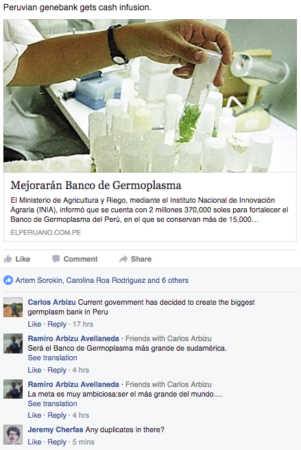- Genetic Diversity of Cultivated Lentil (Lens culinaris Medik.) and Its Relation to the World’s Agro-ecological Zones. 352 accessions, 54 countries, 3 agro-ecological groups (South Asia, Mediterranean, N temperate) in USDA collection.
- Association mapping of seed and disease resistance traits in Theobroma cacao L. 6 and 1 markers, respectively, based on 483 unique trees in the International Cocoa Genebank, Trinidad (ICGT).
- Historic translocations of European larch (Larix decidua Mill.) genetic resources across Europe – A review from the 17th until the mid-20th century. Humans have moved material to areas outside its native distribution, and have mixed up genetically distinct populations in some places.
- Insights into the Genetic Relationships and Breeding Patterns of the African Tea Germplasm (Camellia sinensis (L.) O. Kuntze) Based on nSSR Markers and cpDNA Sequences. African material groups according to where it was bred.
- First the seed, next the smolt? Will salmon farmers learn the right lessons from plant biotechnology? I bet not.
- Geographic patterns of phenotypic diversity in sorghum (Sorghum bicolor (L.) Moench) landraces from North Eastern Ethiopia. There aren’t any. Patterns, that is.
- Subgenome parallel selection is associated with morphotype diversification and convergent crop domestication in Brassica rapa and Brassica oleracea. Similar heading and tuberous morphotypes in the two species are due to parallel selection on genes that diverged after duplication event.
- Assessing the Cost of Global Biodiversity and Conservation Knowledge. Golly, it’s expensive!
- Sixteen years of change in the global terrestrial human footprint and implications for biodiversity conservation. Human footprint hasn’t increased by as much as might be feared, but still extends over 75% of world’s land surface. Let the mashing up with crop wild relatives hotspots begin!
Moral panic and produce
It’s hard to be a hipster these days. No sooner are you told that your quinoa habit is ruining the livelihoods of Bolivian farmers, that news comes along that your guacamole is contributing to deforestation in Mexico. Fortunately, data, and sober analysis, are on hand to provide a measure of reassurance to our beauteously bearded brethren.
Brainfood: African rice, Soybean resistance, Peruvian cuisine, Aromatic rice, Cowpea diversity, Wild barley diversity, High throughput phenotyping, Cacao core, Niche foods, Tajik wheat breeding
- Domestication history and geographical adaptation inferred from a SNP map of African rice. Evidence of strong selection for salt tolerance over protracted domestication period.
- Genome-Wide Association Study of Resistance to Soybean Cyst Nematode (Heterodera glycines) HG Type 2.5.7 in Wild Soybean (Glycine soja). 43 resistant accessions out of 235.
- Food incursions into global heritage: Peruvian cuisine’s slippery road to UNESCO. How the 1% eat.
- Differentiation and description of aromatic short grain rice landraces of eastern Indian state of Odisha based on qualitative phenotypic descriptors. There’s morphological diversity within aromatic types.
- Genetic Diversity and Population Structure of Cowpea (Vigna unguiculata L. Walp). 768 cultivated types from 56 countries in the USDA collection fall out into 3 genetic groups, but no obvious geographical structure.
- Geography of Genetic Structure in Barley Wild Relative Hordeum vulgare subsp. spontaneum in Jordan. 3 genetic groups again, and no geographic or climatic structure, again.
- Utilization of a high-throughput shoot imaging system to examine the dynamic phenotypic responses of a C4 cereal crop plant to nitrogen and water deficiency over time. Who needs morphological descriptors?
- Establishment of a Core Collection of Traditional Cuban Theobroma cacao Plants for Conservation and Utilization Purposes. 185 out of 537 hardly seems worth it.
- Promotion and Utilization of Niche Foods for Food and Nutrition Security. Termites with your spider plants, madam?
- The History of Wheat Breeding in Tajikistan. Seems, according to the authors, to have been a waste of time.
IP for smallholder farmers
Thanks a lot to Susan Bragdon for summarizing her latest paper for us.
The Quaker United Nations Office has released a paper by Chelsea Smith and myself looking at the relationship between intellectual property (IP) and small scale farmer innovation. The paper will also be available in Chinese, French and Spanish shortly.
IP systems are an attempt to incentivize innovation in agriculture and ensure its availability to the public. The familiar mantra holds that breeders and scientists need incentives to create. However, the majority of innovation in agriculture happens in absence of IP rights — on the farm, by small-scale farmers. And what they’re doing is important.
While small-scale farmers themselves are typically not driven to conserve, develop, adapt, invent and otherwise display their immense ingenuity for the ends of attaining exclusionary rights to commercialize their “products”, some kinds of IP tools have the potential to actively support their efforts. Or at the very least leave farmers to do what they do in peace. The paper discusses how alternative or sui generis plant variety protection systems (as opposed to UPOV-style PVP systems), collective and certification trademarks, and geographical indications may support on-farm innovation — when carefully selected and adapted to suit the realities of domestic agricultural sectors.
On the other hand, IP tools that are more conventionally believed to incentivize innovation in agriculture (i.e. patents, UPOV-style PVP systems, and less commonly trade secrets) may actually impede farmers’ innovation.
The paper is part of QUNO’s work to build mutual understanding of the importance of small scale farmers and agrobiodiversity across treaty bodies of relevance. There is quite a complex international legal architecture relating to small-scale farmers, innovation and IP, including the CBD, Nagoya Protocol, ITPGRFA, WTO TRIPS Agreement, UPOV and the WIPO IGC. Unfortunately, we have very little, if any real collaboration going on among the secretariats of these treaties to try to establish some coherence: coordination tends to be limited to formal reports sent from one governing body to another. We’re going to need to do a lot better in order to meet SDG 2 relating to food security.
Peruvian genebank to get bigger, but how much?
There’s much excitement over on my Facebook page about the announcement of a cash infusion for the Peruvian genebank.

I’ll be here, holding my breath.